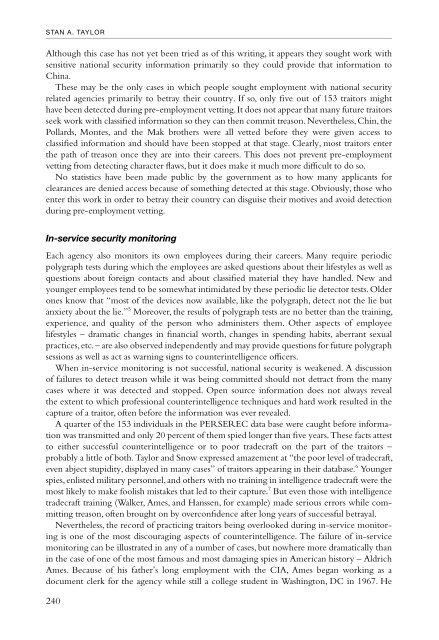Handbook of intelligence studies / edited by
Handbook of intelligence studies / edited by
Handbook of intelligence studies / edited by
Create successful ePaper yourself
Turn your PDF publications into a flip-book with our unique Google optimized e-Paper software.
STAN A. TAYLOR<br />
Although this case has not yet been tried as <strong>of</strong> this writing, it appears they sought work with<br />
sensitive national security information primarily so they could provide that information to<br />
China.<br />
These may be the only cases in which people sought employment with national security<br />
related agencies primarily to betray their country. If so, only five out <strong>of</strong> 153 traitors might<br />
have been detected during pre-employment vetting. It does not appear that many future traitors<br />
seek work with classified information so they can then commit treason. Nevertheless, Chin, the<br />
Pollards, Montes, and the Mak brothers were all vetted before they were given access to<br />
classified information and should have been stopped at that stage. Clearly, most traitors enter<br />
the path <strong>of</strong> treason once they are into their careers. This does not prevent pre-employment<br />
vetting from detecting character flaws, but it does make it much more difficult to do so.<br />
No statistics have been made public <strong>by</strong> the government as to how many applicants for<br />
clearances are denied access because <strong>of</strong> something detected at this stage. Obviously, those who<br />
enter this work in order to betray their country can disguise their motives and avoid detection<br />
during pre-employment vetting.<br />
In-service security monitoring<br />
Each agency also monitors its own employees during their careers. Many require periodic<br />
polygraph tests during which the employees are asked questions about their lifestyles as well as<br />
questions about foreign contacts and about classified material they have handled. New and<br />
younger employees tend to be somewhat intimidated <strong>by</strong> these periodic lie detector tests. Older<br />
ones know that “most <strong>of</strong> the devices now available, like the polygraph, detect not the lie but<br />
anxiety about the lie.” 5 Moreover, the results <strong>of</strong> polygraph tests are no better than the training,<br />
experience, and quality <strong>of</strong> the person who administers them. Other aspects <strong>of</strong> employee<br />
lifestyles – dramatic changes in financial worth, changes in spending habits, aberrant sexual<br />
practices, etc. – are also observed independently and may provide questions for future polygraph<br />
sessions as well as act as warning signs to counter<strong>intelligence</strong> <strong>of</strong>ficers.<br />
When in-service monitoring is not successful, national security is weakened. A discussion<br />
<strong>of</strong> failures to detect treason while it was being committed should not detract from the many<br />
cases where it was detected and stopped. Open source information does not always reveal<br />
the extent to which pr<strong>of</strong>essional counter<strong>intelligence</strong> techniques and hard work resulted in the<br />
capture <strong>of</strong> a traitor, <strong>of</strong>ten before the information was ever revealed.<br />
A quarter <strong>of</strong> the 153 individuals in the PERSEREC data base were caught before information<br />
was transmitted and only 20 percent <strong>of</strong> them spied longer than five years. These facts attest<br />
to either successful counter<strong>intelligence</strong> or to poor tradecraft on the part <strong>of</strong> the traitors –<br />
probably a little <strong>of</strong> both. Taylor and Snow expressed amazement at “the poor level <strong>of</strong> tradecraft,<br />
even abject stupidity, displayed in many cases” <strong>of</strong> traitors appearing in their database. 6 Younger<br />
spies, enlisted military personnel, and others with no training in <strong>intelligence</strong> tradecraft were the<br />
most likely to make foolish mistakes that led to their capture. 7 But even those with <strong>intelligence</strong><br />
tradecraft training (Walker, Ames, and Hanssen, for example) made serious errors while committing<br />
treason, <strong>of</strong>ten brought on <strong>by</strong> overconfidence after long years <strong>of</strong> successful betrayal.<br />
Nevertheless, the record <strong>of</strong> practicing traitors being overlooked during in-service monitoring<br />
is one <strong>of</strong> the most discouraging aspects <strong>of</strong> counter<strong>intelligence</strong>. The failure <strong>of</strong> in-service<br />
monitoring can be illustrated in any <strong>of</strong> a number <strong>of</strong> cases, but nowhere more dramatically than<br />
in the case <strong>of</strong> one <strong>of</strong> the most famous and most damaging spies in American history – Aldrich<br />
Ames. Because <strong>of</strong> his father’s long employment with the CIA, Ames began working as a<br />
document clerk for the agency while still a college student in Washington, DC in 1967. He<br />
240
















